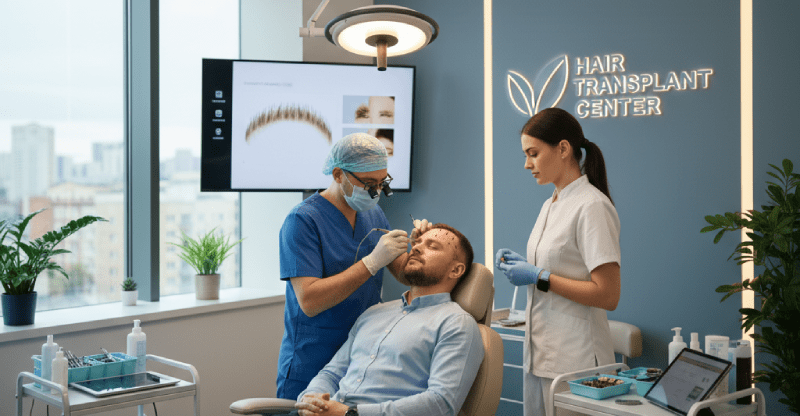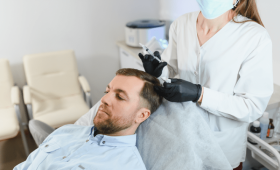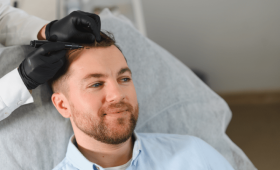Why is Turkey a Popular Destination for Hair Transplantation?
Turkey is a world leader in the field of hair transplantation, and there are many reasons for this popularity. The most important factor is the provision of high-quality services at affordable costs. Hair transplant clinics in Turkey achieve successful results using state-of-the-art equipment and experienced surgeons. The costs, which are much lower compared to Western countries, are a great attraction for international patients.
Furthermore, Turkey’s geographical location and rich cultural heritage also offer a tourism opportunity for those who want to get a hair transplant. Cities like Istanbul and Izmir are ideal centers for both medical tourism and for exploring historical and natural beauties. Lastly, the “all-inclusive” packages provided by clinics in Turkey (accommodation, transfers, and post-procedure care) ensure that patients are comfortable throughout the entire process. All these factors combined make Turkey an unrivaled destination for hair transplantation.
How Much Does Hair Transplantation Cost in Turkey?
The cost of a hair transplant varies depending on many factors. These factors include the number of grafts to be transplanted, the technique to be used (FUE, DHI, Sapphire FUE, etc.), the experience of the clinic and the surgeon, the location of the city where the operation will be performed, and the package content (accommodation, transfers, care products). Hair transplant prices in Turkey are much more economical compared to Europe and America.
Prices can generally range between $1,500 and $4,000 USD. This price difference is due to the lower labor and operation costs in Turkey. However, it should not be forgotten that clinics offering very low prices may compromise on quality, so it is important to consider the clinic’s references and experience, not just the price. Generally, clinics that offer more comprehensive and luxurious services may have slightly higher prices.
What Techniques Are Used in Hair Transplantation?
Today, there are three main techniques widely used in hair transplant operations: FUE (Follicular Unit Extraction), DHI (Direct Hair Implantation), and Sapphire FUE. The FUE technique involves taking hair follicles from the donor area one by one and implanting them into channels opened in the recipient area. This technique is ideal for large areas of baldness and is a less invasive method. In the DHI technique, hair follicles are collected one by one using a special Choi pen and are directly implanted with the same pen.
This method eliminates the need for channel opening and allows for a denser transplant. It is especially preferred for the hairline and for increasing density. Sapphire FUE is a sub-version of the FUE technique where sapphire-tipped blades are used instead of metal for the channel opening stage. Sapphire tips allow for smoother and smaller channels to be opened, which speeds up the recovery process and helps achieve a more natural result.
What is the FUE Technique and How is it Applied?
The FUE (Follicular Unit Extraction) technique is the most common method used in hair transplantation. In this technique, the patient’s donor area (usually the back of the head) is first anesthetized with local anesthesia. Then, hair follicles (grafts) are harvested one by one using a special device called a micromotor. These grafts can contain 1-4 hair strands. The collected grafts are kept in a special solution to preserve their vitality.
Meanwhile, small channels where the grafts will be placed are opened in the bald area. The channel opening procedure is done to match the natural direction and angle of the hair. Finally, the collected grafts are placed one by one into the opened channels. The FUE technique is very popular due to the fact that it leaves no visible scars and has a fast recovery process. The success of the technique depends on the surgeon’s experience and precision during the channel opening.
What is the DHI Technique and What Are the Differences?
The DHI (Direct Hair Implantation) technique, unlike FUE, combines the channel opening and graft placement procedures. In this method, a special tool called the Choi Implanter Pen is used. This pen takes the hair follicle and injects it directly into the bald area. This allows the transplantation process to begin immediately after the grafts are collected, which minimizes their exposure to air and increases their survival rate.
The biggest advantage of DHI is that a denser transplant can be done among existing hairs. This, especially for hair densification operations, is ideal. Furthermore, the possibility of a non-shaven hair transplant is another reason why DHI is preferred. While FUE is more suitable for transplanting to larger areas, DHI is more effective for smaller and more sensitive regions.
What is the Sapphire FUE Technique?
The Sapphire FUE technique is a variation of FUE, with the main difference being the tool used during the channel opening stage. While steel blades are used in the standard FUE technique, Sapphire FUE uses special blades with tips made of sapphire crystal. Sapphire tips are much smoother and sharper than steel blades. This allows the channels for the hair follicles to be opened in a smaller, smoother, and more precise manner.
This minimizes tissue damage and accelerates the recovery process. The Sapphire FUE technique is especially ideal for those who want to achieve a natural look, as the channels opened are better suited to the natural direction and angle of the hair follicles. Furthermore, the smaller size of the channels opened with this technique also allows for an increase in transplant density.
How Long Does a Hair Transplant Procedure Take?
The duration of a hair transplant operation varies according to the number of grafts to be transplanted and the technique used. Generally, a hair transplant operation can last between 4 and 8 hours. This duration includes all stages, such as the application of local anesthesia, harvesting of grafts, opening of channels, and placement of grafts.
The procedure can take up to 8 hours for large areas requiring a high number of grafts. In some cases, for very high graft counts (e.g., 5000+ grafts), the operation may be spread over two days. This is a practice done to increase patient comfort and preserve the quality of the grafts. During the operation, patients can relax, listen to music, or watch movies.

Does the Procedure Hurt?
Since the hair transplant operation is performed under local anesthesia, it is a painless procedure. Before the procedure, the donor area and the area to be transplanted are numbed with needles. Aside from the prick of the anesthesia needles, no pain is felt during the operation. For patients with a fear of needles, some clinics also offer needle-free anesthesia methods. After the operation, there may be a slight soreness or discomfort. This condition is usually easily controlled with painkillers and disappears completely within a few days.
Am I a Suitable Candidate for Hair Transplantation?
Whether you are a suitable candidate for a hair transplant depends on a number of factors. First, the type and cause of hair loss are important. Androgenetic alopecia (male pattern baldness) is the most common type of hair loss, and in this case, a hair transplant is usually successful. Second, your donor area must have sufficient hair density. The donor area is the area from which hair follicles will be taken, and the presence of healthy hair follicles is vital for the success of the operation. Third, your general health must be good. Individuals with chronic diseases such as heart disease and diabetes should be evaluated for suitability for the operation by a doctor. Lastly, being over 18 and having your hair loss process stabilized are also important criteria.
How Many Grafts Are Needed in Hair Transplantation?
The number of grafts needed depends on the degree of the person’s hair loss, the size of the bald area, and the capacity of the donor area. This is a personalized situation and can only be determined by a detailed analysis by an expert doctor. Generally, for those with early-stage hair loss, 1500-2000 grafts may be sufficient, while for those experiencing advanced hair loss, 4000-5000 grafts or more may be needed. The number of grafts is also directly related to the density of hair follicles per cm² in the area to be transplanted. It should be noted that the capacity of the donor area is limited, so it is important to act with realistic expectations.
What Should Be Considered Before the Procedure?
The preparation process before a hair transplant operation is very important for a successful result. It is recommended that you stop using alcohol and cigarettes at least one week before the operation. Alcohol can increase bleeding due to its blood-thinning effect, while smoking can slow down the healing process. Blood-thinning medications such as Aspirin and Vitamin E should also be discontinued 10 days before the operation. If you have a chronic illness or use regular medication, you must inform your doctor. It is recommended that you wash your hair before coming to the operation and wear comfortable clothes during the procedure. It will also be beneficial to have a light breakfast on the day of the operation and avoid caffeinated beverages.
What is the Post-Hair Transplant Recovery Process Like?
The recovery process, although it varies from person to person, generally goes through similar stages. Immediately after the operation, redness, swelling, and light scabbing may be seen in the donor and recipient areas. This is a normal condition. Swelling and redness may increase during the first 3 days, but this condition usually decreases within 1 week. The first wash is done 2-3 days after the operation at the clinic or according to the doctor’s instructions. At the end of the first week, the scabs begin to fall off. In the first month, a large part of the transplanted hair falls out in a process called “shock loss.” This is a necessary stage for new hair to grow. The recovery process takes about one year, and the final appearance of the hair emerges at the end of this period.
What is Post-Hair Transplant Shock Loss?
Shock loss is a natural process after a hair transplant and is not a cause for concern. Due to the trauma the hair follicles receive during the operation, the transplanted hair strands begin to fall out between 1 and 3 months. This loss is not of the hair follicles, but only of the hair strands. The hair follicles are still alive under the skin and have entered a resting phase. After about 3-4 months, new and healthy hairs begin to grow from these follicles again. Shock loss does not mean that the hair transplant has failed, but rather it is a preparatory stage for the growth of new hair. Informing patients about this process beforehand prevents unnecessary anxiety.
When Do the Transplanted Hairs Start to Grow?
The growth process of the transplanted hairs takes place in stages. In the first 3 months, some of the transplanted hair falls out with shock loss. After this period, after about 3-4 months, the hair follicles begin to activate and new hairs begin to sprout. These hairs may be thin and weak at first. From the 6th month, the hair becomes noticeably thicker and grows longer. Generally, at the end of 8-12 months, 80-90% of the hair has grown and reached its final appearance. To see the full results, it may be necessary to be patient and wait up to a year.
How is the First Wash Done After Hair Transplantation?
The first wash after a hair transplant is done 2 or 3 days after the operation, usually by the clinic itself or according to the doctor’s instructions. The first wash is vital to gently clean the transplanted area and help the scabbing begin. During the wash, a special lotion and shampoo are used. The lotion is applied to the transplant area to soften the scabs and is left on for 15-20 minutes. Then, it is rinsed gently with lukewarm water and a special shampoo. During the wash, high-pressure water should definitely not be used, and the transplant area should not be pressed. The washing process should continue in this manner every day until the scabs have completely fallen off.
Which Medications Should Be Used After Hair Transplantation?
It is important to use the medications given to you by your doctor regularly after your hair transplant. Generally, an antibiotic to reduce the risk of infection and a painkiller are prescribed. Antibiotics are usually used for 5-7 days. Painkillers can be taken when needed. In addition, vitamin supplements or hair-strengthening sprays recommended by your doctor can also be used. These products help the new hair to be healthier and stronger. Furthermore, you should definitely not use any other medication without consulting your doctor during the post-operative period.

What Should the Diet Be Like After Hair Transplantation?
Diet after a hair transplant is of critical importance to speed up the recovery process and support the healthy growth of new hair. It is necessary to consume foods rich in protein, iron, zinc, and vitamins A and C. Protein is the basic building block of hair. Iron and zinc help strengthen hair follicles, while vitamins A and C are necessary for tissue repair and collagen production. For this reason, foods such as red meat, chicken, fish, eggs, spinach, almonds, and walnuts should be consumed in abundance. It is recommended to stay away from alcohol and cigarettes for at least 10 days after the procedure and to reduce caffeine consumption. Drinking a sufficient amount of water will also support the recovery process.
Can I Do Sports After Hair Transplantation?
It is necessary to wait for a certain period of time to do sports after a hair transplant. During the first 10 days, heavy exercises and activities that cause sweating should be avoided. Sweating can increase the risk of infection in the transplanted area. Furthermore, contact sports such as basketball and football should be postponed for a while to avoid blows to the head. After the 10th day, light-paced walks and exercises can be done. It is generally recommended to wait 1 month for activities such as heavy cardio and weightlifting. You should also stay away from humid and dirty environments like swimming pools and saunas for 1 month.
How to Choose a Reliable Clinic in Turkey?
Choosing a reliable hair transplant clinic in Turkey is one of the most important steps for a successful result. First, you should focus on clinics that are approved by the Ministry of Health and have all legal documents. The experience of the clinic and the team is very important. It will be useful to examine the certificates of the surgeon or the person who will perform the operation and the results of previous patients. Clinic reviews, patient testimonials, and social media accounts can also give an idea about the quality of the clinic. You should also make sure that the hygiene and sterilization standards are high. Choosing a clinic that offers comprehensive consultation before the operation, answers all your questions, and helps you set realistic expectations is an indicator of reliability.
Is There a Hair Transplant Guarantee?
The success of a hair transplant operation depends on many factors, and therefore some clinics may make different promises under the name of a “guarantee.” However, it should be remembered that the hair transplant process is a biological process and everyone’s healing rate is different. Most reliable clinics are committed to the fact that a large part of the transplanted grafts will remain permanently. It is generally expected that 90-95% of the transplanted grafts will remain permanently. The “guarantee” given by a clinic can usually be in the form of an additional operation or a corrective operation in case of dissatisfaction. A clinic promising you a permanent and unlimited guarantee may be an unrealistic situation.
Can Beard and Eyebrow Transplantation Be Done?
Yes, hair transplant techniques can also be successfully used for beard and eyebrow transplantation. Beard transplantation is generally applied for men with sparse or no beard on their cheeks, mustache, or chin area. In this operation, hair follicles taken from the nape of the neck are transplanted into the beard area. Eyebrow transplantation is performed for individuals who have sparse or lost eyebrows. Since eyebrows determine the facial expression, the correct angle and direction are very important in eyebrow transplantation. In both operations, achieving a natural and aesthetic look depends on the experience of the surgeon who performs the operation.
How Natural Does the Hair Transplant Result Look?
The naturalness of hair transplant results depends on the quality of the operation and the technique used. Modern techniques (especially DHI and Sapphire FUE), when done correctly, give extremely natural results. The most important factors for a natural look are the angle, direction of the channels, and the design of the hairline. Transplanting hairs to match the natural growth direction and angle prevents the results from looking artificial. Furthermore, designing the hairline to suit the person’s face shape and age is also vital for a natural look. An experienced surgeon can achieve excellent results by paying attention to these details.
What Are the Side Effects of Hair Transplantation?
Although hair transplantation is generally a safe operation, some mild side effects may be seen. The most common side effects include swelling, redness, and scabbing in the operation area. These symptoms usually go away on their own within a few days. Very rarely, there may be a risk of infection in the transplant or donor area. To reduce this risk, it is important to use the antibiotics given by the doctor regularly. Temporary numbness or tingling may also be seen after the operation, and this condition usually disappears within a few weeks or months. The risk of a permanent scar after a hair transplant is very low with the FUE technique.
How are Accommodation and Transportation Arranged in Turkey?
Most hair transplant clinics in Turkey offer “all-inclusive” packages for international patients. These packages generally include transfers from the airport to the clinic and hotel, all necessary transfers before and after the operation, and accommodation. The patient only needs to buy their flight ticket. Clinics usually arrange accommodation in 4 or 5-star hotels according to the patient’s preference. Thanks to these packages, patients do not have to deal with logistical details such as transportation and accommodation and have a comfortable experience throughout the entire process.
When is Sexual Intercourse Possible After Hair Transplantation?
Another important issue to consider after a hair transplant is sexual intercourse. During sexual intercourse, heart rate and blood pressure increase, which can cause bleeding in the transplanted area. Also, sweating and friction can damage the transplanted grafts. Therefore, it is recommended to avoid sexual intercourse for the first 10 days after the operation. After the 10th day, you can return to your normal activities, but you should still be careful to protect your head area for the first month.



